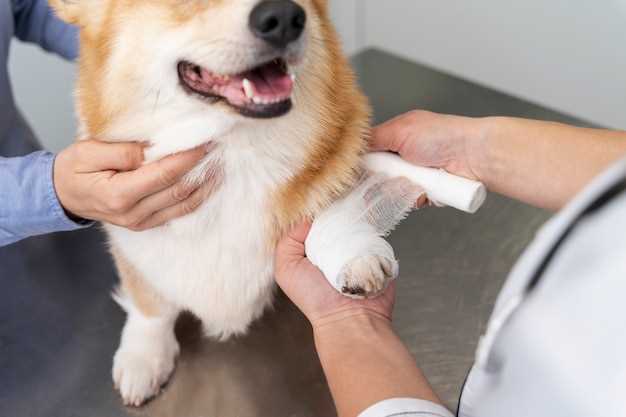
Is your furry friend suffering from hypertension?
Losartan can help manage high blood pressure in dogs.
Find out the right dosage and how it can improve your pet’s health.
Benefits of Losartan for Canines
Losartan is an important medication for dogs as it is commonly used to treat high blood pressure (hypertension) in canines. High blood pressure can lead to serious health issues in dogs, including heart disease, kidney failure, and vision problems. Losartan works by helping to relax blood vessels, which in turn lowers blood pressure and reduces the strain on the heart.
Additionally, Losartan is also used in dogs with kidney disease to help protect the kidneys and slow down the progression of the disease. It can help improve kidney function and reduce protein loss through the urine, which are common problems in dogs with kidney disease.
Overall, Losartan plays a crucial role in managing various health conditions in dogs, including high blood pressure and kidney disease. It is important for pet owners to follow their veterinarian’s dosage and administration instructions carefully to ensure the best outcomes for their furry friends.
Benefits of Losartan for Canines
Losartan is a medication that is commonly used in dogs to treat various conditions, including heart disease, kidney problems, and high blood pressure. Here are some of the benefits of using Losartan for canines:
- Effective in managing high blood pressure in dogs.
- Helps to reduce the risk of heart failure in dogs with heart disease.
- Can improve kidney function in dogs with kidney problems.
- May help to reduce protein loss in the urine of dogs with certain kidney conditions.
- Can help to improve overall quality of life for dogs with chronic health issues.
It is essential to follow your veterinarian’s dosage guidelines and instructions when administering Losartan to your dog to ensure the best possible outcomes and minimize potential side effects.
Dosage Guidelines for Dogs
When it comes to dosing Losartan for dogs, it is crucial to follow the guidelines provided by your veterinarian. The typical dosage range for dogs is 0.1-0.25 mg per pound of body weight, given once daily. However, the actual dose may vary depending on the dog’s condition and response to treatment.
It is important to always administer the medication as prescribed and never exceed the recommended dosage. Overdosing can lead to adverse effects and complications. Additionally, it is best to give Losartan with food to help improve absorption and reduce the risk of stomach upset.
Factors Influencing Dosage
- Age of the dog
- Weight of the dog
- Underlying health conditions
- Severity of the condition being treated
These factors can all play a role in determining the appropriate dosage of Losartan for your canine companion. Your veterinarian will consider all of these factors when determining the right dose for your dog.
Factors Influencing Dosage
When administering Losartan to dogs, several factors may influence the dosage required for optimal effectiveness:
- Weight: The size and weight of the dog play a crucial role in determining the appropriate dosage of Losartan. Larger dogs may require a higher dosage compared to smaller breeds.
- Age: Younger dogs may metabolize Losartan differently than older dogs, affecting the dosage needed for desired results.
- Underlying Health Conditions: Dogs with certain health conditions, such as kidney or liver disease, may require adjustments to the dosage of Losartan to ensure safety and efficacy.
- Response to Treatment: Monitoring the dog’s response to the initial dosage of Losartan is essential in determining whether adjustments are needed for optimal treatment outcomes.
- Veterinary Guidance: It is crucial to consult with a veterinarian to determine the most appropriate dosage of Losartan based on the individual needs and health status of the dog.
Administration of Losartan to Dogs
When administering Losartan to your dog, it is important to follow your veterinarian’s instructions carefully. Here are some tips to ensure proper administration:
1. Dosage: Always give the prescribed dosage of Losartan to your dog. Do not increase or decrease the dose without consulting your vet.
2. Timing: Give Losartan to your dog at the same time every day to maintain a consistent level of the medication in their system.
3. Food: You can give Losartan with or without food, but it is best to be consistent with your choice to avoid any potential interactions.
4. Monitoring: Keep a close eye on your dog after giving them Losartan. Watch for any signs of improvement or adverse reactions and report them to your vet.
5. Storage: Store Losartan in a cool, dry place away from direct sunlight and out of reach of children and pets.
By following these guidelines, you can ensure that your dog receives the full benefits of Losartan therapy while minimizing the risk of any negative effects.
Tips for Giving Losartan to Your Dog

When administering Losartan to your dog, it is important to follow certain guidelines to ensure the medication is given safely and effectively. Here are some tips to help you give Losartan to your canine companion:
| 1. | Always give Losartan as prescribed by your veterinarian. Do not adjust the dosage without consulting them first. |
| 2. | Administer Losartan with or without food, as directed by your vet. Some dogs may experience stomach upset if given on an empty stomach. |
| 3. | Make sure your dog consumes the entire dose of Losartan. If they spit out the medication, contact your vet for further instructions. |
| 4. | If your dog misses a dose of Losartan, give it as soon as you remember. However, if it is almost time for the next dose, skip the missed dose and continue with the regular schedule. |
| 5. | Monitor your dog for any signs of improvement or adverse reactions while on Losartan. Report any concerns to your vet promptly. |
Monitoring the Effects of Losartan

Once your dog starts taking Losartan, it’s important to monitor its effects closely. Here are some key points to keep in mind:
- Observe your dog regularly for any changes in behavior or symptoms.
- Monitor your dog’s blood pressure if possible to track any improvements or fluctuations.
- Keep a log of your dog’s daily activity levels, appetite, and water intake.
- Work closely with your veterinarian to assess your dog’s response to Losartan.
By monitoring the effects of Losartan on your dog, you can ensure that the medication is working effectively and address any concerns promptly.
Signs of Improvement or Adverse Reactions
It is important to closely monitor your dog for any signs of improvement or adverse reactions when administering Losartan. Here are some key indicators to watch for:
| Signs of Improvement | Adverse Reactions |
| – Decreased blood pressure | – Vomiting |
| – Improved kidney function | – Diarrhea |
| – Increased energy levels | – Lethargy |
| – Increased appetite | – Changes in urination |
If you notice any of the adverse reactions mentioned above or any other unusual symptoms in your dog after administering Losartan, consult your veterinarian immediately. Regular monitoring and communication with your vet will ensure the safe and effective use of Losartan for your canine companion.
